Dieser Text ist zur Zeit nur auf Englisch verfügbar...
Research Expedition to Fiji –5.4 – 21.4.19
After 39 hours traveling from Bremen to Fiji, we (Véronique Helfer and Martin Zimmer of ZMT, working group Mangrove Ecology) arrive in Nadi in the evening of 05.04. Anika Methner (Leibniz Institute German Collection of Microorganisms and Cell Cultures, DSMZ) had arrived one day earlier already, and Chris Ulpinnis (Leibniz Institute of Plant Biochemistry, IPB) earlier on the same day. They warmly welcome us at the hotel, but we are only up for a light dinner and rest…
After a good night's sleep, another four hours car ride brings us to Suva. Here, we will spend the next two weeks for sampling sediments, leaves and roots in the mangroves around Laucala Bay within our interdisciplinary global project DiSeMiNation (Digging into Sediments and Microbes for Nature conservation).
On the way, we met Victor Bonito of Reef Explorer Fiji Ltd. to discuss issues of mangroves along the south coast of Viti Levu Island, being threatened by illegal construction and land-reclamation activities.
Sunday, 07.04.: Meeting our major local collaboration partner, Dr Stuart Kininmonth of the University of the South Pacific (USP), for planning field work and the upcoming Mangrove Stakeholder Workshop to be held at USP– organized with the invaluable help of the Dean Dr Bibhya Sharma and Harmindar Kaur.
In the evening we can welcome our colleagues from the Leibniz Institute of Ecological Urban and Regional Development (IÖR), Ralf-Uwe Syrbe and Karsten Grunewald, at the Colo-I-Suva Rainforest resort, and our team is complete…
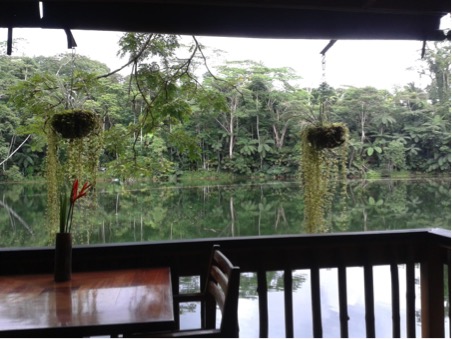
View from the breakfast porch of the Colo-I-Suva eco-lodge
Monday, 08.04.: Last preparations and organisation steps for the upcoming workshop. On campus, we luckily run into Richard Titoko, a human geographer at USP, with whom Martin and Véro had been in touch already two years ago. Quickly inviting him on short notice to the workshop ensures the participation of at least one villager (beyond the mostly academic group of participants), Hemo, the head of one of the villages of the locally managed marine area of Navakavu (villages of Nabaka, Nammakala, Muaivuso and Waiqanake), and member of the iqoliqoli (traditional fishing grounds) committee. It will further open the opportunity for having a post-workshop excursion to one of the villages west of Lami/Suva (Muaivuso Village) and the nearby mangroves and discuss the success story of the MPA. The villagers had planted mangrove patches over the last twenty years in front of their villages to protect them from storm surges and coastal erosion – two years ago, we had done some measurements of wave attenuation in one of these patches together with Alessio Rovere and Elisa Casella within a ZMT-funded project on using drone imagery for predicting the mangrove health status.
Tuesday/Wednesday, 09./10.04.: Stakeholder Workshop with local representatives of the university, Conservation International, and the above-mentioned locally run MPA. The workshop, coordinated and organized by Ralf-Uwe and Karsten, and introduced by Martin, providing an overview of the DiSeMiNation project and its aims to the workshop participants, and by a talk about the status and manifold uses of mangroves by local communities by Randy Thaman (USP), will help us explain how mangroves are perceived and used by the local society. It further develops ideas for future joint collaborative projects (beyond DiSeMiNation) by listing research questions of high priority to colleagues from USP. A more detailed report on the workshop will be available through the DiSeMiNation webpage.
During the excursion, we learn from Hemo that the villagers explain why the sediment inside the mangroves is so smelly: tiri extracts all the dirty things from the air and transports it down there via the prop roots:
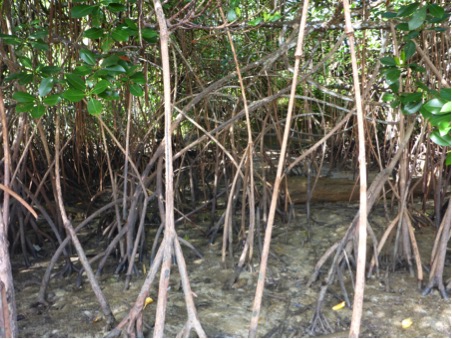
Traditional fisheries use Bai ni ika (fences for fish), built of stems of mangroves (probably dogo), to trap fish during the high tide – exactly the same technique of catching fish is used in Northern Brazil … 15,000 km away from here…
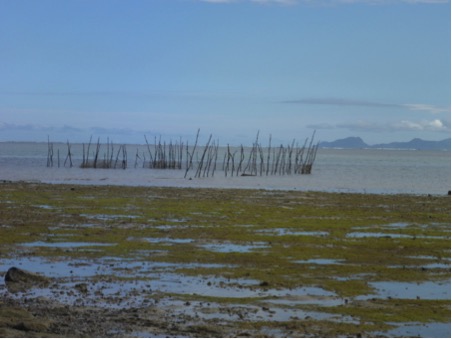
Bai ni ika next to Muaivuso Village
Thursday, 11.04.: Finally, we make it to the field. Together with the crew, Captain Jimocy and Luke, we take a boat trip around the wide delta of the Rewa River east of Laucala Bay. On the way to the village, where we are to meet the chief for a sevusevu, a ceremony that will consult the ancestors of the village and will provide permission to us to enter and sample the surrounding mangroves, we run into Semi from the village of Laucala, the contact between USP and the chief. As the channels into the mangroves are narrow, and even the big streams are often very shallow next to the river bank that hosts the mangroves, we will take Semi and his canoe onto the boat for our sampling trips. Captain Jimocy will navigate us as close as possible to the mangroves, from where Semi will paddle us into the flooded forests – or at least next to their margin, so we can climb from the canoe onto the roots and stems of the luscious vegetation.
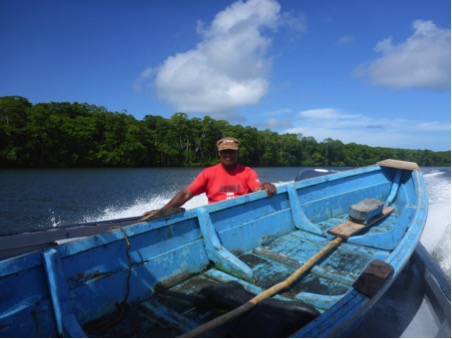
Hemo, our field guide and canoe-driver, and his canoe onboard the Fetutai, Capt. Jimocy's boat, that bares us throughout the week:

Boating through Nakelo River (most eastern branch of the Rewa delta), Nasali River (central branch), Rewa River (main branch) and Vunivudra River (western side arm, joining Laucala Bay together with Vunidawa River) offers a brilliant insight into the local situation and allows us to select our sampling sites along a triplicate salinity gradient of the delta. The plan is to have 9 sites (3 each at Nakelo, Nasali and Vunivudra/Vunidawa) with two plots, each, consisting of stands of Rhizophora (either stylosa or samoensis) (tiri) and Bruguiera gymnorhiza (dogo).
The entire recce was essentially based on previous screening of satellite images for patches of tiri and dogo close to each other and along the environmental gradients we want(ed) to sample. Some of the envisaged sites proved to not be accessible by the boat, so we had to change plans and adapt the sampling scheme on the run, while exploring the channel system of the Rewa River delta.
Friday, 12.04.: We are all set for sampling. The tidal timing is not optimal, but we have to face the fact and do our sampling (partly at high tide, i.e., at inundated mangrove plots) anyway. It's the first time for Anika and Chris to set foot in mangroves … they are deeply impressed by the environment and the working conditions … but these first sites are easy going – it will get worse ;-)
Nevertheless, the first sampling with the new team takes longer than anticipated: the sediment is relatively coarse and solid, but the network of prop roots of the tiri is dense. The tide is too high to efficiently walk on the ground, and we have to climb – fully equipped and packed – the roots for reaching the plot, setting up the plot and measure sediment parameters (mostly Martin's job) and sampling the water-logged sediments (Véro and Anika) and roots (Anika and Martin). The canopy of the 6-8 m high trees is so dense that there are only few leaves in reach from the ground, and we (mostly Chris) have to climb up the prop roots and stems to collect green yellow and brown leaves of representative trees – when we are done with the first two plots (= one site) at Nakelo river, it is time for the crew to get back (Friday, time for the weekend; no overtime working hours announced, and we have to call it a day).
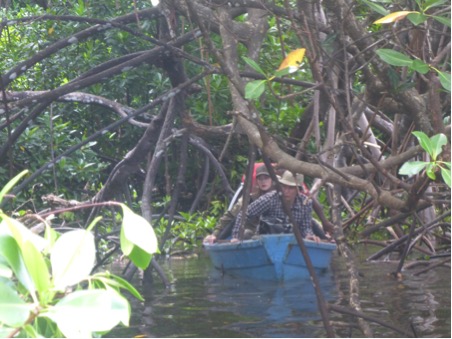
When the tide is too high for walking into the mangroves, Hemo takes us with his canoe through little entangled and enchanted creeks…
Taking into account that this is supposed to be the rainy season, we are very lucky with the weather … to speak with Sting: "heavy clouds but no rain…". What renders the sampling difficult, though, is the inundation of the mangrove stands by the tides: how do you sample sediment in a sterile way (for making the analysis of microbial communities and activities possible) in 40 (or more) cm-deep water?
Saturday, 13.04.: Another early start, planning for three sites today, two at Nakelo, one at Nasali. The weather is nice and dry … blue skies and humid heat inside the mangroves.
Sampling is much faster than yesterday … but still takes quite some time…
Entering the mangroves with the canoe through a narrow and tightly overgrown channel, we reach one of these open and light dogo stands. Semi tells us there are no medium-sized trees, because the villagers used to come here for wood-cutting –dogo provides high-quality fire wood– but insists on stressing that they don't do that anymore, since the forestry department put a ban on mangrove-cutting. In general, it is interesting to notice that the use of mangrove resources, be it fish, crabs, fruits or wood, or plant tissues for medical purposes, is much more diverse here in Fiji than in most other mangroves we visited around the world. This might be related to the remoteness of Fiji – Fijians could not rely on resources from outside but would have to find solutions locally.
The tiri in front is not suitable for sampling – too narrow and too mixed. We take the canoe into another side channel of the creek, and after some prospection, Martin finds a tiri plot with beautiful tangles of prop roots that join the main stems more than 3 m above the ground. Another enchanted place…
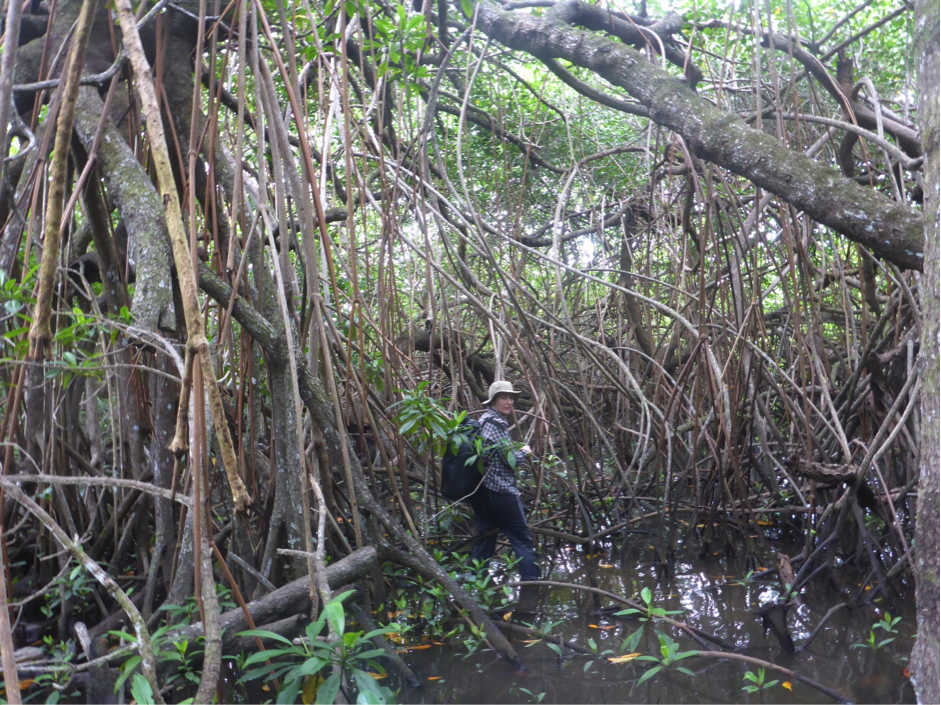
Véro looks like a dwarf underneath the luscious network of prop roots
On the way back to the boat from the second site, Martin walks into a wasp nest. Chris and Anika suddenly see a swarm of 30-40 large wasps (of the size of the European hornet) cloud up around him. Somehow, he manages to escape and is stung only twice; the others are warned and manage to walk around without any further harm … but a lot of root-climbing.
After the second site, we realize that we might be able to sample a third one before dusk, but we will still have quite some distance to travel back by boat to the university jetty – we all agree that two sites per day will be it for the rest of the stay, leaving another three days of sampling.
Sunday, 14.04.: It's Anika's birthday today – little time to celebrate in the morning, however. The tides are high (and incoming) and the clouds are low. Because it is Sunday, and the crew deserves some rest (= early end of the sampling day), we decide to sample the sites closest to the port today: Vunivudra and Vunidawa River, feeding into Laucala Bay.
Thanks to the high tides and the steep river bank, we enter the mangroves by foot, even walking on dry ground, after the Captain had run the boat right into a plot with an impressive web of plank roots (Xylocarpus granatum; dabi). We find our way into a dense tiri stand that is still high enough above the tidal level to do the sampling fast and with dry feet.
It proves much more difficult to find a suitable dogo spot … large enough for our sampling scheme, without intermingled other species. We have to leave walk and climb out the mangroves towards the channel, against the incoming rising high tide, to be picked up by the boat and deposited 100 m further downstream. We hardly set up the plot and started sampling … and "here comes the rain again…" (Eurythmics) … hard and heavy this time … Within minutes, we get soaked wet to the bones … which soon is not a hassle anymore: once you are wet, it can't get worse. The hassle, is the sampling itself: how to label tubes and bags, when everything is dripping, how to take photos of the plots, when the lenses of the camera are full of drops, and there is no dry tissue to remove them? When we reach the boat again, the Captain tells us that the rain was so intense that he had to turn on the boat's pumps to empty the hull from the flood…
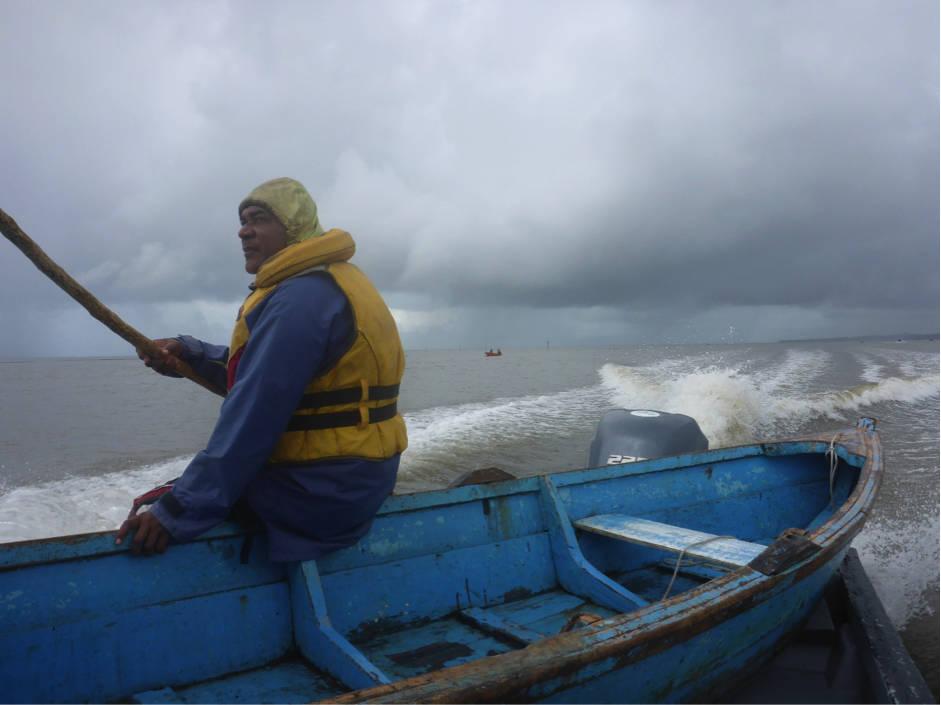
…it can be chilly in Fiji … Luke, our "first officer", protects himself against rain and windy spray…
The sun dares come out again (but not for long) as if to make fun of us and to pretend wanting to dry us … but there is no time for lamenting … off we go, still wet, to the second site of the day (Vunidawa River) that brings no further surprises are events to mention…
Monday, 15.04.: As the days before, the tiri is dense and hard to access … but the dogo forest(s) behind are just beautiful open forests, being flooded twice a day, with huge majestic trees of 12-14 m height and a dense sun-lid understory of recruits of different age-classes and cohorts. Other than that, however, as is typically for many mangroves that are not blessed by high humidity, there is only little understory … just occasionally an epiphytic fern or orchid, a vine, or the globally spread mangrove fern, Acrostichum aureum.
Today, we are up for two sites along Nasali River. As almost always, we have to take the long route through the inland stretch of the river, as the water between the coast line and the reef in front would be too shallow to travel.
The first site is done so quickly that we get over-ambitious and think we might be able to finish three sites today. However, finding the second site takes ages: we had planned to go a bit upstream into lower salinity, but Semi can convince us that there is hardly any dogo in this area – everything we had prospected on the satellite image turns out to be terrestrial vegetation. We finally find a site in the middle between the first one and the last one at Nasali (on the coastline). Entering through a little channel, we wade and walk into a dogo stand with terrestrial vegetation nearby and some coco palm seedlings around. Upon finishing this plot, the tides reach slack, and we walk back to the river bank to sample the tiri … however, the tide is so high (almost spring tide) we would be hip-deep in water, if we walked on the ground … no chance to sample under these conditions…
We take the canoe out to the boat, join the crew and wait for one hour for the water to retreat … we slightly miscalculated the time of slack high tide, though, and even when we start setting up the plot and sampling inside a jungle of strong walkable prop roots, the water is still so deep that Martin has to wrap signal tape around the roots and branches rather than pushing signal sticks into the ground, and Véro has to lean into the water until her ear touches the water surface to reach the sediment below…
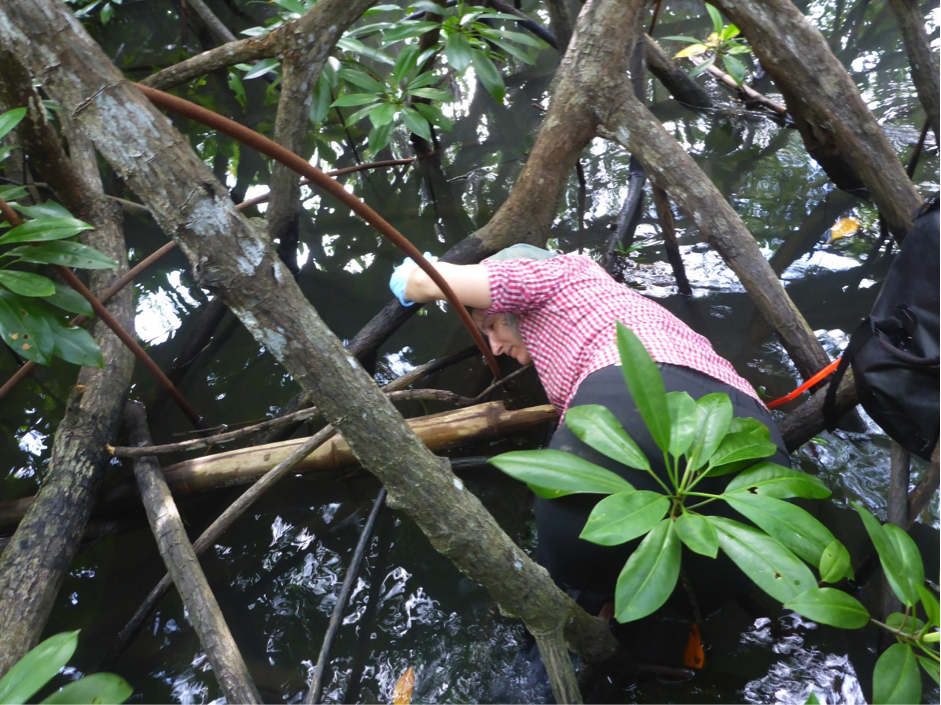
Mangrove sediment-sampling for the advanced…
After a very promising start, we are again so late that we cannot even think of thinking of a third site…
Tuesday, 16.04.: The boat is booked by other researchers. This gives us the chance to carefully and thoroughly clean all equipment and get a day of "rest", making use of it for meeting colleagues of USP (Richard Titoko and his team, Stuart Kininmonth, and Susanna Piovano) for discussing potential future collaboration, and Martin giving a seminar on "What we (need to) know for efficient conservation and sustainable management of mangroves".
Wednesday, 17.04.: As a result of yesterday's discussion, we are accompanied today by Arti Reddy, a MSc student who works on a blue-carbon project supervised by our USP partners Stuart Kininmonth and Nick Rollings. She is a geology student and has never before worked in a mangrove – she wants to get inspired by the way we sample (even though she will be taking deeper sediment cores) and to discuss her project scheme "on the run" with our field work.
Only two sites left – we start with the one at the north-eastern border of Laucala Bay (a prolongation of the Vunivudra/Vunidawa-sampling). It is low tide, and for entering the tiri in the front line, we have to walk to knee-deep soft mud for a distance of more than 100 m … quite some challenge with all the equipment on the back and in hands…
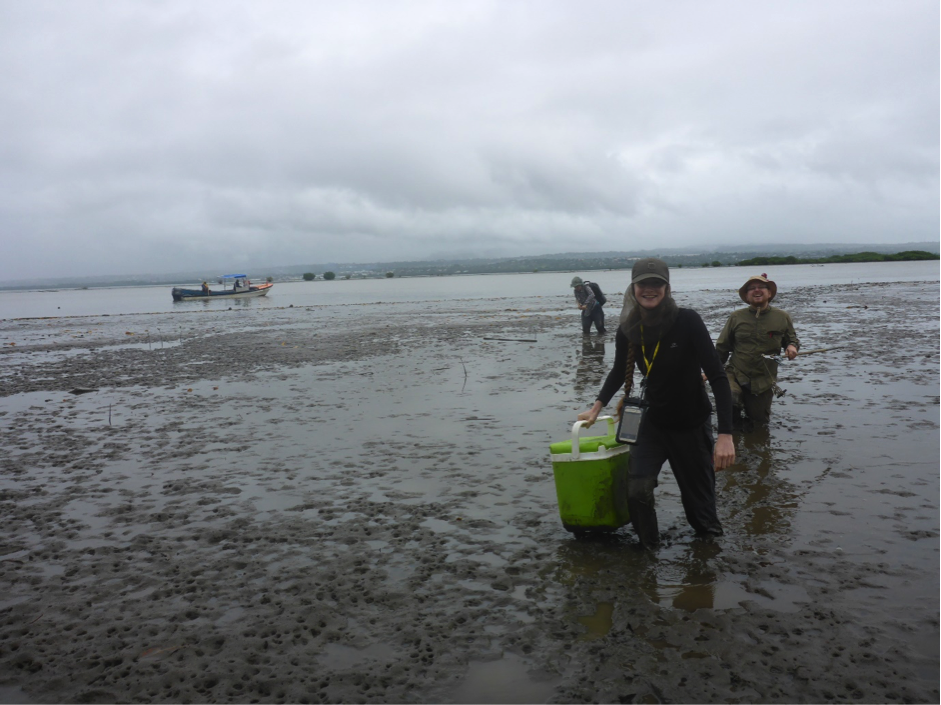
Getting dirty but having fun – our beginners get the real mangrove feeling…
Once in, and as the tides are low, and the two plots are directly next to each other, we are fast – upon finishing, the water level rose enough (and we are clever enough to leave the mangroves at a different point than we entered them) to make it possible for Semi to come and pick us up with his canoe (which, however, sometimes gets stuck in the muddy sediment).
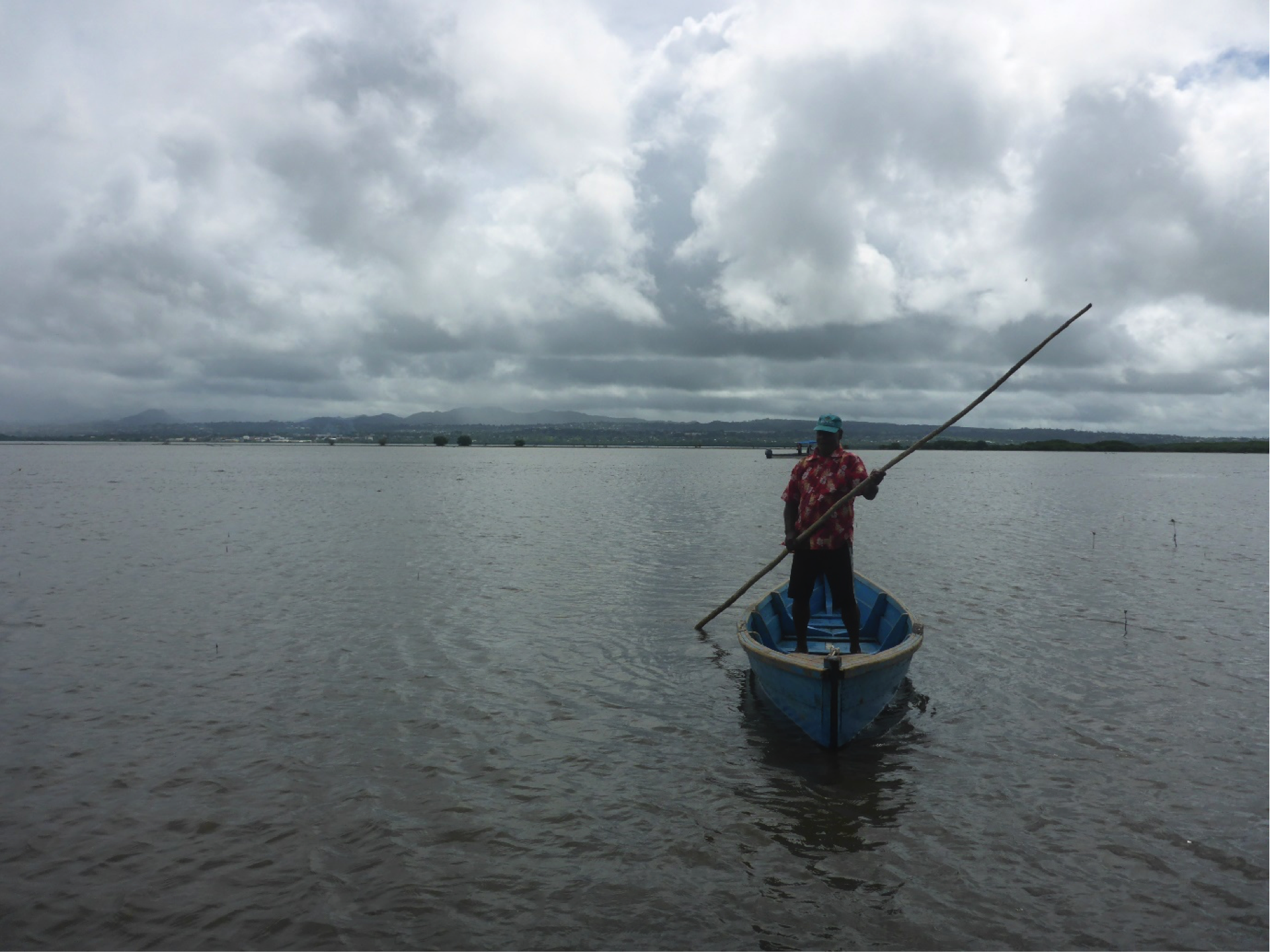
Wading and sampling in inundated mangroves has the advantage of leaving the mangroves less dirty, less covered with mud all over the body – or at least all the way up to the hips. Today, we are dirtier than ever before during the last week, but we spend some time in the water to clean ourselves before entering the boat.
The last site is the coastal stretch of Nasali River. After a long ride through the inland stretch of the river system, Capt. Jimocy has to drop us almost in the middle of the channel, and Semi takes us into an enchanted channel separating the mainland mangroves from a small mangrove-covered island on the seaside. The tiri is still dry, when we start sampling, but the tide comes in rapidly, and we have to rush to be able to finish sampling in time. The dogo stand behind is another beautiful light-drowned forest … we cannot even say whether the dense tangled roots of tiri or the open air of the dogo are more mesmerizing… At this plot, the trees are so tall (and the canopy so high) that Chris has to walk quite some distance to find suitable trees for sampling leaves…
One observation (that we had made before in some dogo plots) catches our attention: mud lobster (maná), like we had seen in Singapore, heap up sediment mounds around the stems of large dogo trees (and sometimes in the open sediment in between) that are then colonized by large crabs. A similar situation of crab-born sediment mounds around individual trees of Ceriops tagal was the trigger of a study that we had performed three years ago in East Australia. Teddy Fong of USP told us later that maná is an important source of income for some villages, and that we were in Fiji right in time for the sampling season – we did, however, see them on the market only once…
For the way back, we once again decide to take another way: the little channel we used for entering is probably too deep for walking already, so we directly head to the main river channel, wading hip-deep in the incoming high tide or, whenever possible to avoid that, climbing over prop roots. Semi picks us up a last time and brings us back to the boat. We take the long river ride again and drop Semi at his village – then it's time to say good-bye and thank you … see you for our next field trip in Fiji!
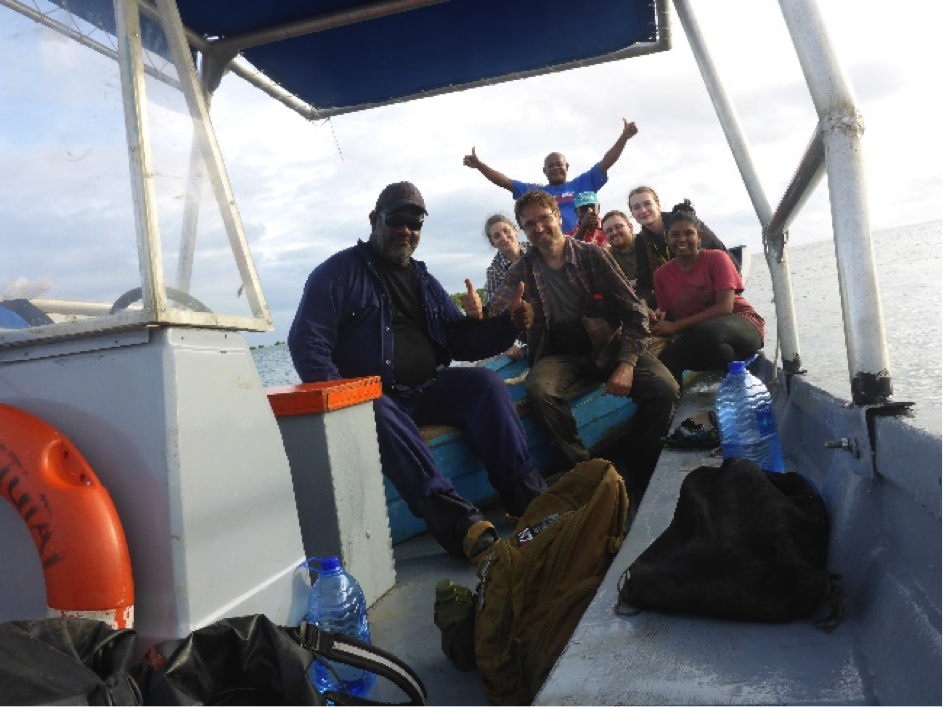
"The Team" onboard the Fetutai – from left to right: Capt. Jimocy (in front), Véro (in the middle), Martin (in front), Luke (in the back), Semi, Chris, Anika, Arti
Thursday, 18.04.: Being done with the field sampling gives us plenty of time for meeting more colleagues for project planning, Marta Ferreira, Tomasi Tikoibua and Teddy Fong, Senilolia Tuiwawa of Conservation International…
The same on Friday, 19.04. – long and extensive meetings and discussions with Utkal Mehta and Ramesh Subramani.
Saturday, 20.04.: Last things to do, tidying up and cleaning the equipment, packing for tomorrow's trip back to Nadi…
Sunday, 21.04.: … we "take the long way home" (Supertramp), along the North Route, passing by Rakiraki, Ba and Lautoka, where we get a first idea of the Northern coast mangroves of Viti Levu … maybe for future visits and projects … who knows…?
Martin Zimmer, Véronique Helfer, Chris Ulpinnis and Anika Methner




